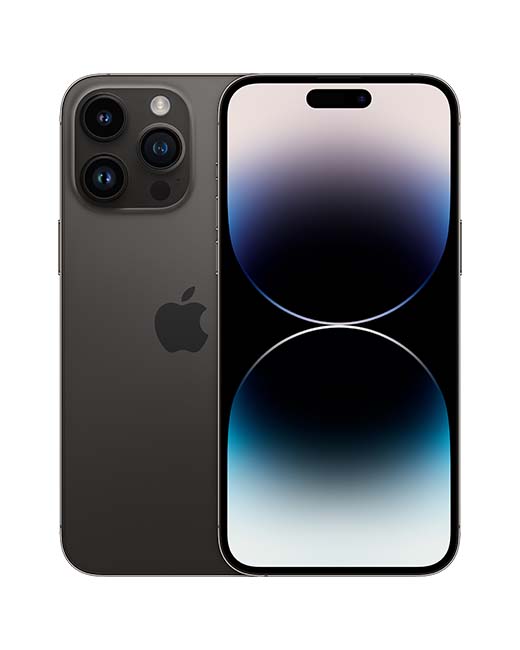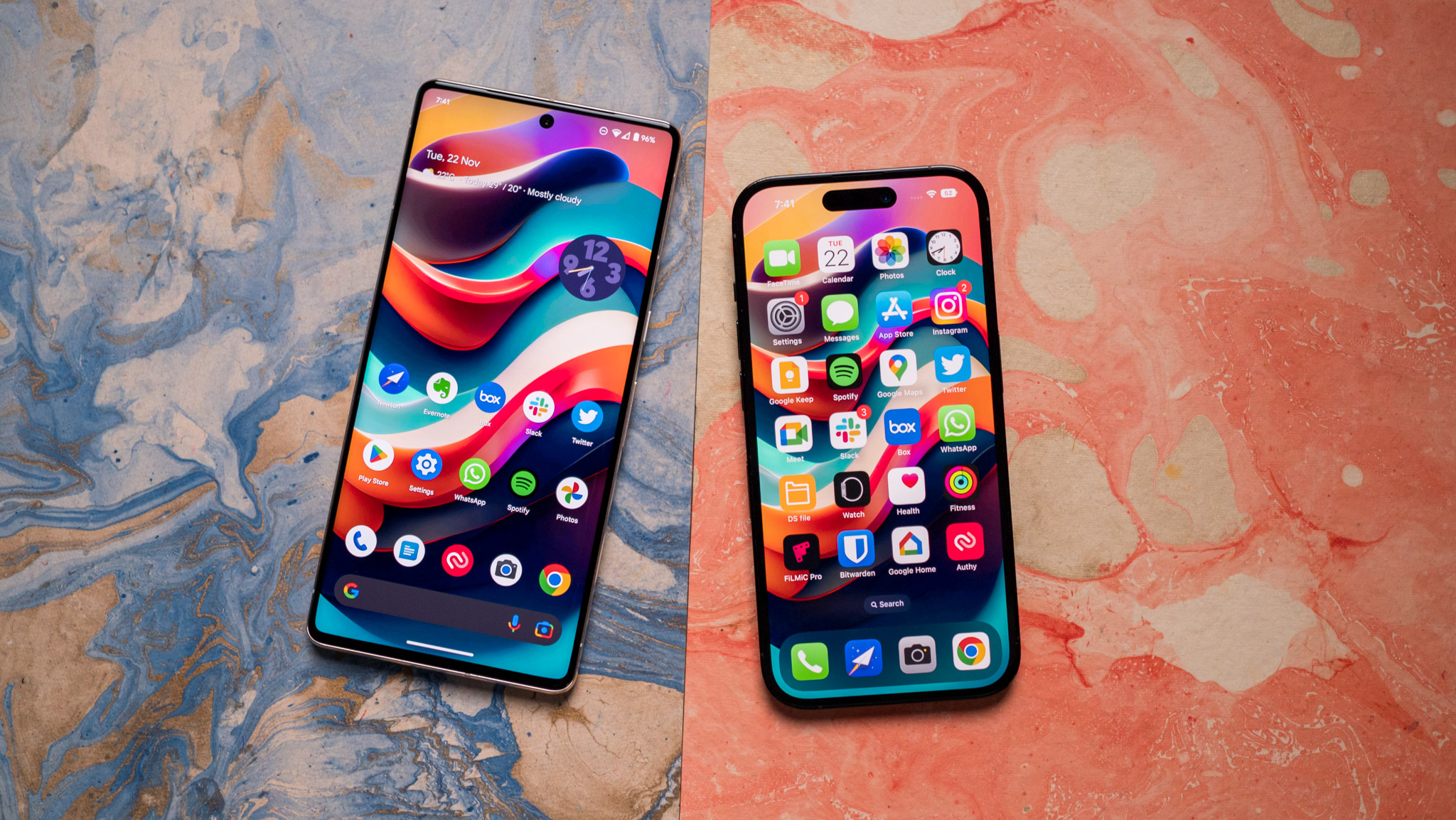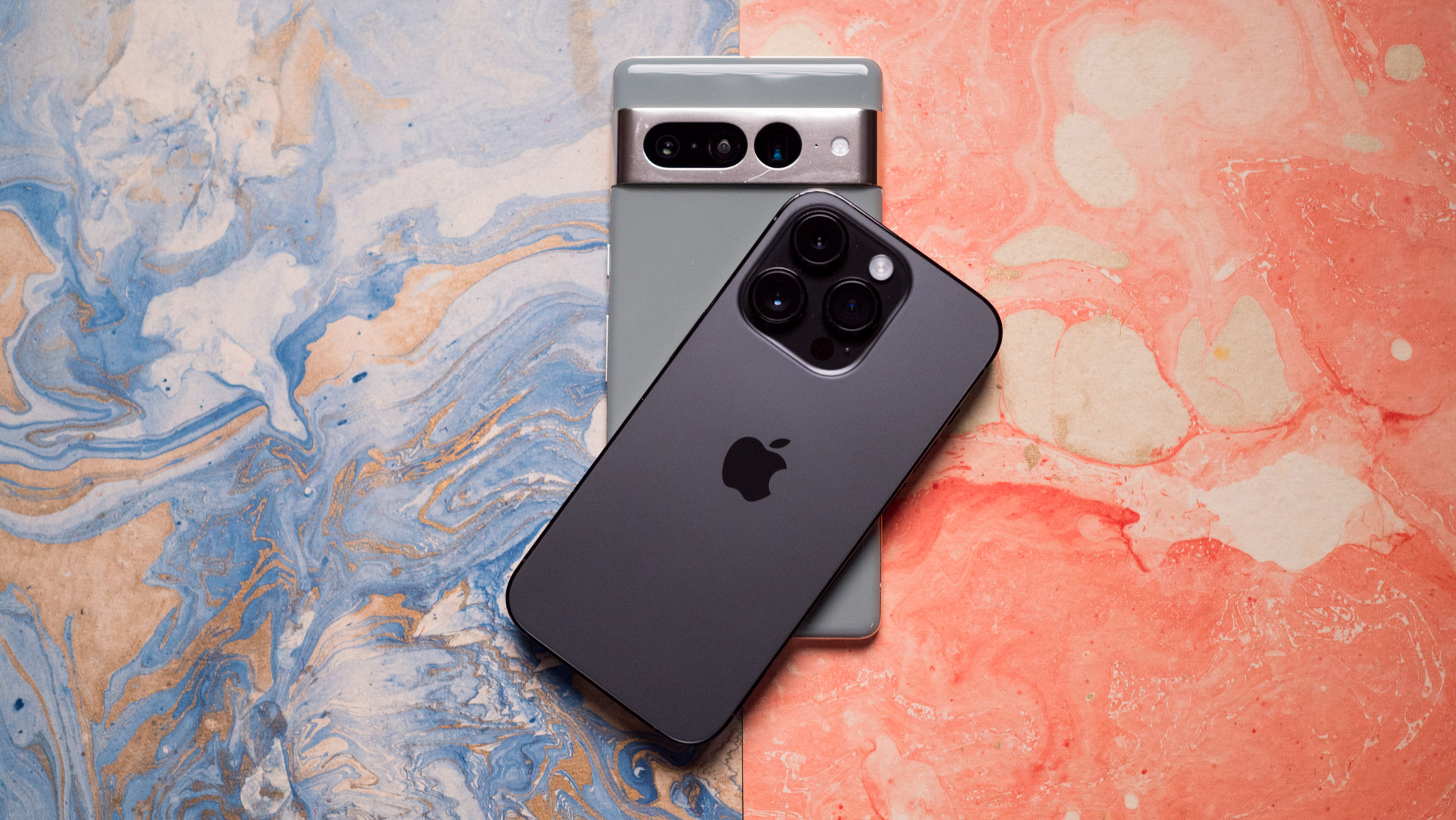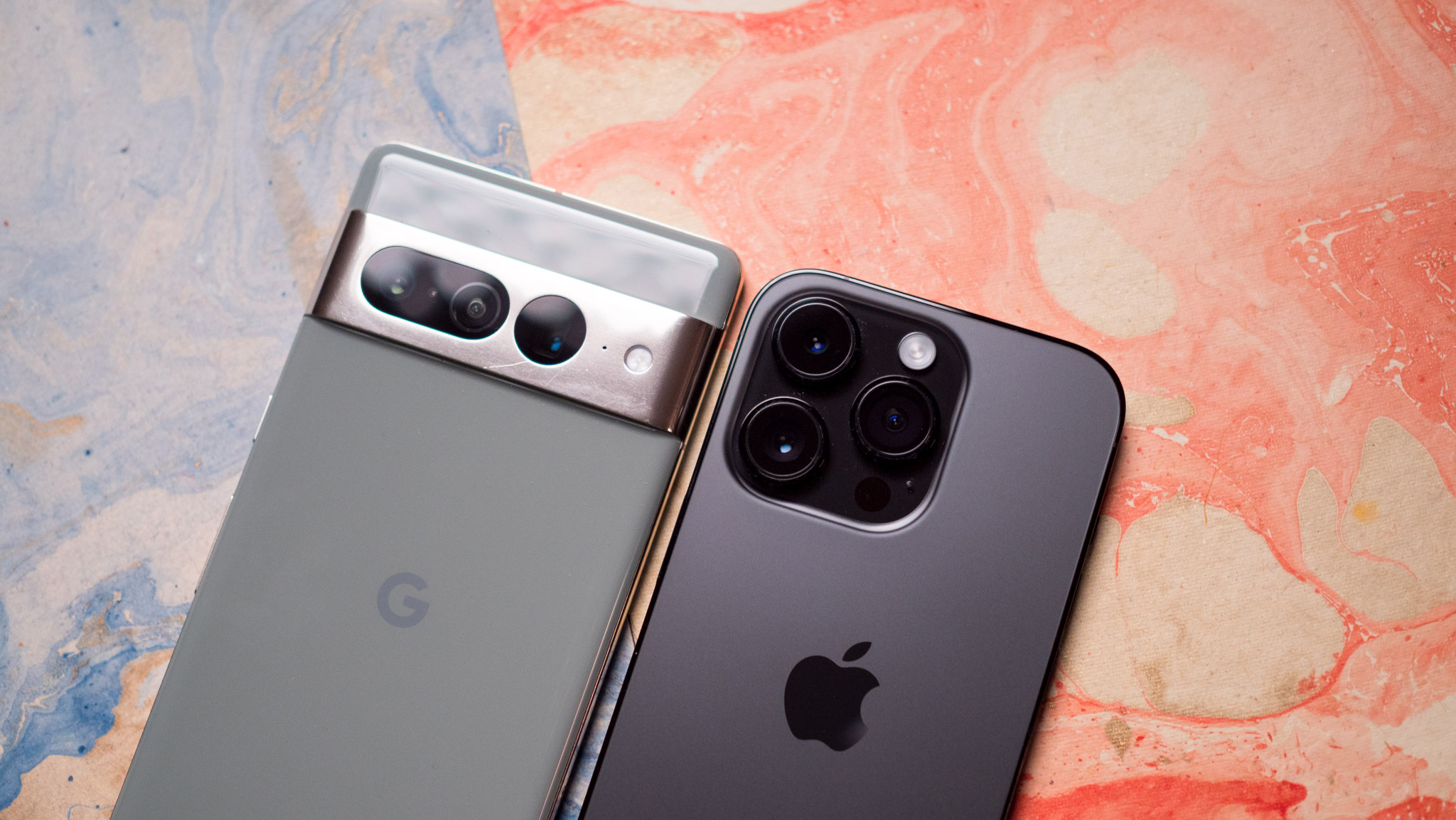Google Pixel 7 Pro vs. Apple iPhone 14 Pro: Which flagship should you buy?
See how Google's latest goes up against the best that Apple has to offer.

Best of Android
The Pixel 7 Pro is my pick for the best overall Android phone you can buy at the moment. It has a polished design that's great to hold and use, the large AMOLED screen is vibrant and fluid in daily use, and you get powerful internal hardware. The best part about the Pixel 7 Pro has to be the camera; Google outdid itself here, delivering a truly phenomenal camera that holds up in just about any scenario. Combine that with clean software, all the hardware extras you need, and a good value, and you get the phone to beat right now.
Pros
- Vibrant 120Hz AMOLED screen
- Powerful hardware with AI features
- Incredible cameras
- Unique software features
- Fast in-screen reader
- Android 13 with no bloatware
Cons
- Face unlock isn't reliable
- No charger in the box

Best of iOS
The iPhone 14 Pro is a mobile powerhouse, offering the fastest internal hardware of any phone. You also get a sleek design with a chassis that's comfortable for one-handed use, a new cutout at the front that's interactive, and outstanding cameras that raise the bar for video recording. There's a lot of new software features as well, and other than the Lightning port, the iPhone 14 Pro doesn't really miss out on much. If you're interested in seeing what iOS has to offer, this is the phone to get.
Pros
- Fantastic OLED screen
- New 48MP camera takes outstanding photos and videos
- Dynamic Island has a lot to offer
- Fastest mobile hardware around
- At least five platform updates
Cons
- Always-on mode has limited use
- Still no USB-C charging
- Average battery life
- No SIM slot in the U.S.
Google has steadily refined its hardware efforts over the last three years, and the result is that the Pixel 7 Pro ticks all the right boxes for a high-end phone. It has a gorgeous design, all the extras you need, and amazing cameras. It needs to be flawless because it is going up against the might of the iPhone 14 Pro. With both phones offering noteworthy hardware backed by stellar cameras, let's find out how they measure up against each other.
Pixel 7 Pro vs. iPhone 14 Pro: Design

It's clear that brands aren't willing to change the design aesthetic too much between generations, and as a result the Pixel 7 Pro features a similar design language as its predecessor. You get the same dual curved screen with identical curves at the back, but the curvature itself is minimal, so there aren't any issues with usability here. There's a similar camera bar that runs across the back, and this time, the entire housing is made out of metal and blends more elegantly into the mid-frame.
I like the curvier design of the Pixel 7 Pro, but that's just my preference. As far as usability goes, the smaller iPhone 14 Pro is better in daily use.
The effect is quite striking, and the Pixel 7 Pro is the best-looking phone Google has produced thus far, particularly in the Hazel variant I'm using. The green design pairs really well with the gold accents around the mid-frame and the camera bar, and the phone looks like upmarket.
Coming to the iPhone 14 Pro, the focus this year is at the front, with the familiar notch making way for two smaller cutouts that are joined together. This Dynamic Island gives the iPhone 14 Pro a fresh look up front, and the fact that the area around the cutout is usable — surfacing notification alerts, timers, and so on — makes it that much more enticing.






Other than that, the design itself hasn't changed at all. The iPhone 14 Pro has the same flat sides as its predecessor, and the camera island at the back has large rings around the three modules. While I'm not usually a fan of phones with flat sides, the iPhone 14 Pro is an outlier — the size and heft of the device make it easier to hold and use than the curvier Pixel 7 Pro.
Of course, a big part of that has to do with the screen. The iPhone 14 Pro has a smaller 6.1-inch panel, with the Pixel 7 Pro offering a 6.7-inch screen. As such, the iPhone 14 Pro is 15.4mm shorter and 5.1mm narrower, making it fit better in your hand. The matte sides also make a difference here, and I would have liked to see a similar coating on the Pixel 7 Pro as well.
To sum it up, the Pixel 7 Pro and iPhone 14 Pro offer a familiar design with a few refinements, and both devices justify the exorbitant retail price.
Get the latest news from Android Central, your trusted companion in the world of Android
Pixel 7 Pro vs. iPhone 14 Pro: Screen

The Pixel 7 Pro features a 6.7-inch QHD+ (3120 x 1440) AMOLED screen with 120Hz refresh, with the iPhone 14 Pro offering a 6.1-inch (2556 x 1179) OLED with 120Hz refresh.
The large 6.7-inch QHD+ AMOLED panel on the Pixel 7 Pro is an absolute joy to use.
Both panels are vibrant and offer incredible colors and contrast, and they hit 1,000 nits maximum brightness in auto mode. The iPhone 14 Pro goes up to a staggering 2,000 nits for select HDR content, with the Pixel 7 Pro able to hit 1,500 nits. You get dynamic scaling with both phones as well, with the refresh rate dynamically scaling all the way down to 1Hz based on the content on the screen. This ensures the battery doesn't drain needlessly when viewing static content like images; in this scenario, the screen refresh falls to 1Hz.
You get a lot of extras and customization options, and having used the Pixel 7 Pro alongside the iPhone 14 Pro for just over two months, I can confidently say that they're among the best screens you'll find in this category. The 6.7-inch screen on the Pixel 7 Pro makes it the ideal choice for streaming videos and playing games, and although it has a larger screen, it isn't unwieldy to use.

Switching over to the iPhone 14 Pro, the key talking point is the Dynamic Island. The cutout doesn't look as ungainly as its predecessor, and it makes the phone look just that bit more modern. I like the new design quite a bit, and while the cutout is significantly larger than what you get on the Pixel 7 Pro, it is usable. It serves as a dock of sorts for whatever is running in the background, including active timers, streaming music, and so on.
Dynamic Island steals the show for the iPhone 14 Pro, and you get an always-on mode for the first time.
Another new feature on the iPhone 14 Pro is an always-on mode, a first for iPhones. It isn't similar to what you get on Android phones, where the screen is turned off and you see a widget that shows time, incoming notifications, and battery. Here, the screen just goes a little dim but shows the background and any widgets you select on the lock screen. I'm not a fan of how the feature works, and I much prefer the way it is handled on the Pixel 7 Pro.
You also get stereo sound on both devices, and the onboard audio gets sufficiently loud and detailed that you can stream videos without requiring wireless earbuds. Overall, you get vibrant screens with the latest OLED tech and extensive customizability, with the Pixel 7 Pro offering a large screen real estate and the iPhone 14 Pro aimed at one-handed use.
Pixel 7 Pro vs. iPhone 14 Pro: Internal hardware

When you're paying nearly $1,000 for a phone, you'd want the best possible hardware. Thankfully, the Pixel 7 Pro and iPhone 14 Pro deliver the goods in this area, offering the latest internals along with all the extras you could ask for. The Pixel 7 Pro features Google's Tensor G2 platform, offering two Cortex X1 cores along with a combination of Cortex A78 and A55 cores.
Google didn't do with the latest Arm v9 cores, nor has it switched the node to 4nm, continuing with the same 5nm fabrication as last year. But what's new here is a renewed focus on AI workloads, and that gives the device a distinct lead over its immediate rivals. With the iPhone 14 Pro, you get the A16 Bionic that's built on a 4nm node and features two all-new Everest cores that go up to a staggering 3.46GHz and four Sawtooth cores.
Of the two, the iPhone 14 Pro is the more powerful option. Google didn't change the fundamentals too much over the first-gen Tensor, but the A16 Bionic features new cores at higher frequencies, and it has a huge lead over its Android rivals in single- and multi-core workloads.
| Category | Pixel 7 Pro | iPhone 14 Pro |
|---|---|---|
| CrossMark (Overall) | 855 | 1328 |
| Productivity | 904 | 1299 |
| Creativity | 768 | 1517 |
| Responsiveness | 1001 | 950 |
| Geekbench 5.1 (single-core) | 1036 | 1882 |
| Geekbench 5.1 (multi-core) | 3075 | 5400 |
| 3DMark Wild Life (score) | 6034 | Maxed out |
| 3DMark Wild Life (FPS) | 36.15 | Maxed out |
| 3DMark Wild Life Extreme (score) | 1802 | 3371 |
| 3DMark Wild Life Extreme (FPS) | 10.8 | 20.2 |
The iPhone 14 Pro is the outright winner in all workloads, and that's down to the advances with the A16 Bionic. With Google instead focusing on AI-backed features in lieu of the latest Arm cores, the Pixel 7 Pro isn't quite on par with the iPhone 14 Pro or the best Android phones in this area.
That said, there are no slowdowns here whatsoever, and both devices are fantastic in daily use. They have more than enough headroom for multitasking and playing visually-intensive titles, and that isn't going to change for a few years. While Chinese brands have started offering 256GB of storage with their high-end devices, both phones here come with 128GB of storage for the base model. The Pixel 7 Pro has 8GB of RAM as standard, with the iPhone 14 Pro offering 6GB across the board.
You don't miss out on any extras as well, with both phones offering IP68 dust and water resistance as standard. There's wireless charging and reverse wireless charging as well, and on the battery side of things, the Pixel 7 Pro has a 5000mAh unit with the iPhone 14 Pro offering a 3200mAh battery. Thanks to the significantly larger battery, the Pixel 7 Pro lasts longer in daily use — even with heavy use, it managed to deliver over a day's worth of power.
The iPhone 14 Pro also manages to last a day, but with heavy use that involves navigation and over 4.5 hours of screen-time, you will need to plug it in before the day's out. On that front, the Pixel 7 Pro has 23W wired and 15W wireless charging, with the iPhone 14 Pro going up to 20W wired and 15W wirelessly over MagSafe. Neither device comes with a charger in the box, so you will have to pick up a USB-C wall charger.
Pixel 7 Pro vs. iPhone 14 Pro: Cameras

The biggest differentiator for high-end phones is the camera, and the Pixel 7 Pro and iPhone 14 Pro have a lot to offer in this area. Both phones have three camera modules with versatile lenses, and rely on AI-assisted features to deliver outstanding shots in just about any situation.
Let's start with the Pixel 7 Pro; the phone has a 48MP f/1.9 primary lens with OIS, a 12MP f/2.2 wide-angle lens with a 126-degree field of view, and a 48MP f/3.5 telephoto option with OIS that delivers 5x optical zoom. Google also went with a new 10.8MP camera at the front with a wide field of view — making it ideal for selfies — and the ability to record 4K video.
With this generation, Google made several tweaks to its Night Sight and Real Tone algorithms, delivering clearer images at night and accurate skin tones. Video stabilization is much better this time around as well, and while earlier devices in the series were mainly aimed at taking still images, the Pixel 7 Pro does a fantastic job taking video. All three cameras can shoot 4K video at 60fps and feature 10-bit HDR, and the new Cinematic Blur feature effortlessly blurs out the background in a video.
Coming to the iPhone 14 Pro, the phone has new hardware in the form of a 48MP f/1.78 main lens with second-gen sensor-shift OIS, a 12MP f/2.2 wide-angle lens, and a 12MP f/2.8 telephoto with OIS that has 3x optical zoom. You won't find as many changes to the camera tuning here, but the larger sensor does an incredible job in challenging scenarios, delivering gorgeous shots. In a similar vein, the iPhone 14 Pro continues to excel at video, with features like native Dolby Vision recording and Cinematic Mode giving the device a distinct edge.
Google made several tweaks to its camera tuning algorithms this year, and that is immediately evident with the Pixel 7 Pro. Pixels have always been in the lead in this area, and the Pixel 7 Pro does an outstanding job in any lighting situation. In this image of the Corsair 5000T, the Pixel 7 Pro does a better job managing colors and highlights, and the iPhone 14 Pro also has a strong showing, maintaining detail and vibrancy.
The Pixel 7 Pro pulls into a distinct lead in these two photos, delivering great color accuracy and detail with little to no noise in the background. That isn't the case with the iPhone 14 Pro, and there is visible noise in the shot of the Gimli figurine. On that note, the Pixel 7 Pro continues to do an outstanding job taking portrait shots of objects; no other phone comes close in this regard.
The Pixel 7 Pro delivers a better shot of my bookshelf, retaining a lot of the finer details and maintaining color accuracy. The iPhone 14 Pro isn't quite as good, and while you get a more contrast-heavy image, the definition around the origami figurines isn't as detailed.
Overall, the Pixel 7 Pro is still in the lead when it comes to still photos, and Google has made tangible strides on the video front this year. That said, the iPhone 14 Pro also has a strong camera, and it pulls into the lead when shooting video. Why I like the Pixel 7 Pro is the fact that I get a great shot on the first try — even if there's little to no lighting or if the subject is constantly moving.
Pixel 7 Pro vs. iPhone 14 Pro: Software

The Pixel 7 Pro is the first phone with Android 13 out of the box, and the iPhone 14 Pro is the first to launch with iOS 16. Android 13 is a modest change that doesn't have much in the way of groundbreaking features, instead delivering further refinement over the Android 12 release. By contrast, iOS 16 comes with a lot of new features, including lock screen customization, the new always-on mode, Dynamic Island on the Pro models, and notification-related tweaks.
You'll find a refined interface on both phones, with the Pixel 7 Pro offering a little bit more on the customization front thanks to the Material You aesthetic. It's easy to change the look and feel of the UI with bright accent colors, and Google did a great job making the interface fun to use. There isn't any bloatware either, and the clean UI combined with the unique software additions that Google added here make the Pixel 7 Pro a delight to use.
I like most of the changes in iOS 16 as well, and the iPhone 14 Pro is great to use as a daily driver. That said, I'm not a fan of how many ads are showing up in iOS these days, and file system access is needlessly convoluted. Other than those irritations, iOS 16 is good in daily use.
Pixel 7 Pro vs. iPhone 14 Pro: Which should you buy?

The Pixel 7 Pro is a fantastic showcase for Google's hardware ambitions, and is the best overall Android phone you can get today. Samsung's Galaxy S22 Ultra comes very close, and while that phone has additional features and a better design, it costs a lot more. For under $1,000, the Pixel 7 Pro is the outright winner.
Picking a winner here is all down to preference — both the Pixel 7 Pro and iPhone 14 Pro are fantastic in their own right.
Google nailed the design and in-hand feel of the Pixel 7 Pro, and the 120Hz AMOLED screen has been a delight to use. I haven't run into any issues on the hardware side of things, the battery easily lasts over a day, and the clean software with no bloatware gives the device a distinct edge. But the biggest selling point of the Pixel 7 Pro is the cameras; you're guaranteed to get outstanding shots in any scenario, and there isn't another phone that delivers consistently great photos the first time around.
Then there's the fact that you now get features exclusive to the Pixel 7 Pro, like Photo Unblur. These unique additions go a long way in making the phone that much more useful, and you won't find the features on any other device.
Now, there's a lot that the iPhone 14 Pro gets right as well: the design itself hasn't changed too much, but it is easier to hold and use than the Pixel 7 Pro, has a fabulous screen, fastest hardware of any phone today, and amazing cameras. While it lacks some of the extra AI-backed features that you get on the Pixel 7 Pro, the iPhone 14 Pro is better for video recording. And of course, Dynamic Island on the iPhone 14 Pro unlocks a new set of use cases and makes the cutout area that much more interactive.
Choosing between the two comes down to what you want in a phone, because there isn't inherently missing on either device here. If you've already used Android for a while now and want the best phone currently available, the Pixel 7 Pro is the obvious choice — I don't see myself switching to another device until the Galaxy S23 comes along. But if you're an iPhone user or are interested in trying out iOS, the iPhone 14 Pro is a fabulous choice.

The Pixel 7 Pro is my current recommendation if you want the best Android device. It has a gorgeous design, smooth 120Hz AMOLED screen, fast internal hardware, and outstanding cameras that continue to set the standard for the category. Throw in a clean software with zero bloatware and exclusive features like Photo Unblur, and you get a fantastic overall device.

With an exciting new design at the front and the fastest mobile hardware of any phone, the iPhone 14 Pro has a lot going for it. It continues to push the boundaries for video recording, and will get more software updates than the Pixel 7 Pro. If you want to try out what iOS has to offer, this is the phone to get.

Harish Jonnalagadda is Android Central's Senior Editor overseeing mobile coverage. In his current role, he leads the site's coverage of Chinese phone brands, networking products, and AV gear. He has been testing phones for over a decade, and has extensive experience in mobile hardware and the global semiconductor industry. Contact him on Twitter at @chunkynerd.
